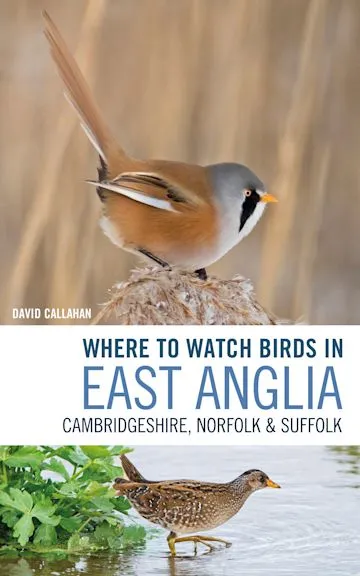
Courtesy of its geographic position, diversity of lowland habitats and extensive coastline, East Anglia is high on the list of desirable UK birding destinations. Even in this age of web- and app-based resources, there is still a place for ‘where to watch’ books and this comprehensive site guide to such an attractive birding region will be of interest to local and visiting birdwatchers alike.
Overall, the book does a very good job of cramming in lots of information in a manageable format, including a liberal scattering of clear and largely accurate maps, and tabular summaries of expected species for all the main sites. One disadvantage of a printed site guide is the rate at which bird distributions are changing but the perilous status of Willow Tit in East Anglia, for example, is reflected as accurately as can be expected for a book published in 2020. Perhaps more surprising is the inclusion of at least one site that had already ceased to exist as a gull-watching spot long before the book’s publication: Blackborough End Tip.
I initially found the indexing system confusing, until I realised that the numbers alongside species names refer to sites rather than page numbers. This can make it hard to pin down mentions of a given species, particularly as some sites span up to six pages. Whilst recognising that public transport is limited in many parts of East Anglia, and cycling infrastructure less well developed than it should be, it was disappointing that many ‘Finding the site’ sections do not offer alternatives to the private car, nor information about access for people with a mobility impairment. Where either of these are mentioned, it is typically at the end of the section, rather than the start – an opportunity missed.
Locations are grouped in six sections: Cambridgeshire, The Fens and the Ouse Washes, Norfolk, Breckland, The Broads National Park, and Suffolk. The choice of sections makes perfect sense, even though some straddle one or even two county boundaries. However, considering that the Broads National Park is treated separately from Norfolk and Suffolk, it was odd to find sites such as Carlton Marshes SWT, whose website describes it as “the southern gateway to the Broads National Park”, in the Suffolk section. In contrast, all the sites covered in The Broads National Park section are in Norfolk. In addition to the main sites, there are also ‘subsidiary’ sites; it would have been good to see this term explicitly defined in ‘How to use this book’. Site names are listed in the Contents, by area, but not indexed at the end. This might make it hard to navigate for anyone who has heard a particular site being mentioned but is not sure which part of East Anglia it is in.
Having visited most of the ~150 sites covered, and being familiar with around half of them, I found the majority of entries to be accurate, informative and enticing. There are some minor inaccuracies, such as the suggestion that Wood Sandpiper is “among the scarcer species” that can be encountered at RSPB Snettisham, whilst White-rumped Sandpiper is described as a “remote possibility” (along with Pectoral and Buff-breasted Sandpipers). In reality, White-rumped Sandpiper is far more frequently recorded than Wood Sandpiper there, due to the largely saline/brackish nature of the wader habitat. One site inclusion and one omission caught my eye: Scolt Head Island is given two pages, including a small map that is of very limited value. However, this site is difficult to reach and explore, hence not suitable for one of the book’s key target audiences (according to the introduction): first-time visitors to the region. In contrast, BTO Nunnery Lakes, with its diverse mix of wetland, woodland and drier habitats – and within easy reach of several key Breckland sites – does not even feature as a subsidiary site.
By and large though, this book stakes a strong claim to being “the definitive guide to the birding highlights of the region”, as stated on the back cover, and certainly “contains a comprehensive review of all the major sites, and many lesser-known ones” that will interest any birdwatcher destined for this bird-rich corner of Britain.
Reviewed by
- Author: David Callahan
- Publisher: Helm, London
- Publication year: 2020
- ISBN: 9781472962225
- Format: Paperback
- Page count: 366
- RRP: £25.00
- Available from: NHBS
